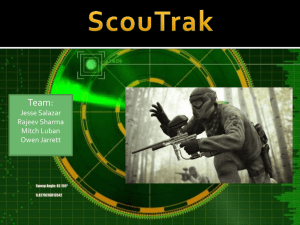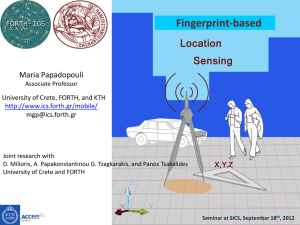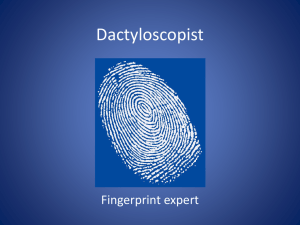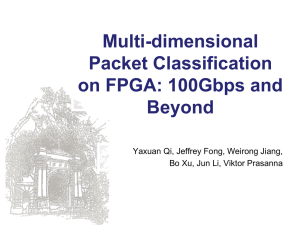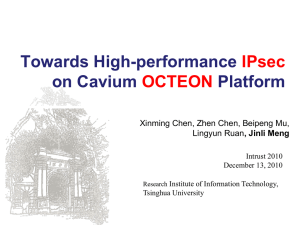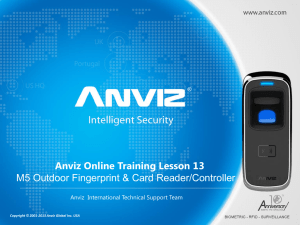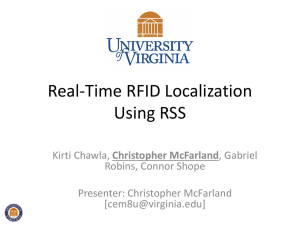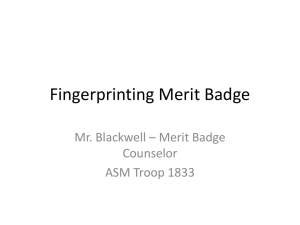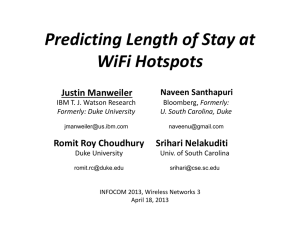FreeLoc - Network and Systems Lab
advertisement
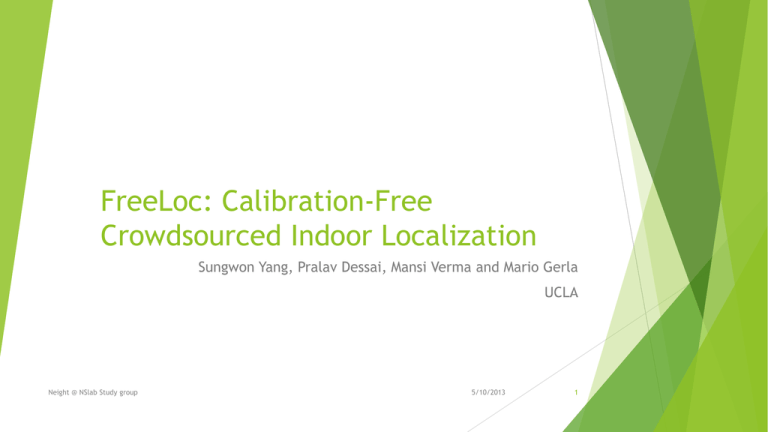
FreeLoc: Calibration-Free Crowdsourced Indoor Localization Sungwon Yang, Pralav Dessai, Mansi Verma and Mario Gerla UCLA Neight @ NSlab Study group 5/10/2013 1 Outline Introduction Fingerprint value extraction Localization algorithm Evaluation Neight @ NSlab Study group 5/10/2013 2 Introduction Investigate 3 major technical issues in crowd sourced indoor localization system: 1. No dedicated surveyor. Can’t afford long-enough time for survey and Can’t sacrifice their device resources 2. No constraint on type & number of device. 3. There are no designated fingerprint collection points. Different user can upload their own fingerprint with same location label. Contributions: 1. Present a method that extracts a reliable single fingerprint value per AP from the short-duration RSS measurements 2. Proposed novel indoor localization method, requires no calibration among heterogeneous devices, resolves the multiple surveyor problem 3. Evaluate system performance Neight @ NSlab Study group 5/10/2013 3 System overview Send measured RSSI and request location info. Multiple-surveyor-Multiple-user System Every one is contributor & user Fast radio map building & update Similar system exists, but still some challenges not being addressed in the related work A,B upload Fingerprint data with location label Neight @ NSlab Study group 5/10/2013 4 System Challenges RSS Measurement for short duration To construction a robust and accurate radio map, more RSSI samples is better Update map / large area is time consuming Short-time measurement is necessary Device Diversity Multi-path fading in indoor environment cause RSSI to fluctuate overtime Different designed hardware ( Wi-Fi chipset, antenna,…etc ), RSSI varies even though collect at the same location Multiple Measurements for one location in crowd sourced system Different surveyor might reply different RSSI fingerprint even though they are in the same location area. Multiple fingerprints for a location is not effecient Neight @ NSlab Study group 5/10/2013 5 Outline Introduction Fingerprint value extraction Localization algorithm Evaluation Neight @ NSlab Study group 5/10/2013 6 Fingerprint value extraction AP response rate AP were not recorded in some fraction of the entire Wi-Fi scanning duration Their preliminary result: RSSI > -70dbm provides over 90% response rate -70dbm < RSSI < -85dbm provides 50% response rate RSSI < -90dbm provides very poor response rate Given lower weight to weak RSSI, discount the AP response rate for fingerprint information Neight @ NSlab Study group 5/10/2013 7 Fingerprint value extraction RSS variance over time RSSI value observation result in their testbed Top figure : collect RSSI for 1 HR Middle/Bottom : collect for 1 minute Collect frequency: 0.5-1Hz, depend on different device Related works often suggests using the mean value of RSSI or using Gaussian distribution model Fig.(a) an example, the RSSI histograms are strongly left-skewed. Gaussian model can’t fit well. Also, mean value is not always the best idea Fig.(a) an example, mean value work well Fig.(b) an example, long time & short time variation could degrades the localization accuracy. Neight @ NSlab Study group 5/10/2013 8 Extraction Method Observation Findings: The most-recorded RSSI in the case of the short duration measurements is very close to the most recorded RSSI in long-duration cases fpValue is the fingerprint value for an AP RSSpeak is the RSS value with highest frequency The width of the range being averaged is set by 𝑾𝑳𝑻 and 𝑾𝑹𝑻 Select stronger RSS value as the fpValue if more than one RSS value has the same frequency in a histogram However, it’s difficult to adjust 𝑾𝑳𝑻 and 𝑾𝑹𝑻 and RSSpeak move slightly left or right each time depend on environment factors Neight @ NSlab Study group 5/10/2013 9 Extraction Method Modified Modified Fingerprint model Use one width w and set it enough large Euclidean distances between Fpvalue from one-hour measurement and one-minute measurement with respect to log scale Averaging 50 measurements and more than 10 AP recorded in each measurement and find w Neight @ NSlab Study group 5/10/2013 10 Outline Introduction Fingerprint value extraction Localization algorithm Evaluation Neight @ NSlab Study group 5/10/2013 11 Localization Algorithm BSSID vector, 𝑅𝑆𝑆𝐼 < 𝑅𝑆𝑆𝐼𝑘𝑒𝑦 − 𝛿 Fingerprint of location lx Relative RSS comparison Keyi is the BSSID with ith strongest RSSI Surveyors Users Neight @ NSlab Study group 5/10/2013 12 Localization Algorithm Let us see the example… Neight @ NSlab Study group 5/10/2013 13 Localization Algorithm 8pts Location result would be in 101 Relative RSS comparison Surveyors Users 1pts Neight @ NSlab Study group 5/10/2013 14 Localization Algorithm 9pts Location result would be in 101 Relative RSS comparison Surveyors Users 2pts Neight @ NSlab Study group 5/10/2013 15 Localization Algorithm High rank key If no high rank key match, label location as unknown Relative RSS comparison Surveyors Users Neight @ NSlab Study group 5/10/2013 16 Heterogeneous Devices Radio map work well, even though heterogeneous devices involved. Due to not use absolute RSS value, but utilize relationship among RSSI The 𝛿 relieves the degradation of localization accuracy. AP not detected Neight @ NSlab Study group 5/10/2013 17 Multiple Surveyors More than one user can upload their own fingerprints Maintain only one fingerprint Update fingerprint become possible, by merge fingerprint Neight @ NSlab Study group 5/10/2013 18 Evaluation adjacent of point 1.5m Corridor width 2.5m Environment Setup 70 different locations at the engineering building in university Fingerprint comprised information Timestamp BSSID (MAC address) RSSI Four different devices adjacent of point 6m Motorola Bionic, HTC Nexus One, Samsung GalaxyS and GalaxyS2 Two main scenario result would be show in this work Neight @ NSlab Study group 5/10/2013 19 Pairwise Devise Evaluation Overall, best delta value is 12 In laboratory, best delta value is around 12, Cross device error<2m Find out whether the proposed method of building fingerprint and using it for indoor localization works well with heterogeneous devices Find out the optimal δ value, to be used for subsequent experiments Collect data over 3 days Neight @ NSlab Study group 5/10/2013 In 3rd Floor, best delta value is about 9, Cross device error<4m 20 Merge Fingerprint Different device mechanism might help fingerprint not affect to increase localization localization accuracy accuracy Impact of Device Heterogeneity Wi-Fi fingerprinting data for each location was taken from multiple devices and data from all other mobile phone devices Neight @ NSlab Study group In 3rd Floor In laboratory 5/10/2013 21 Impact of Multiple surveyors Constructed the fingerprint map for a particular room using heterogeneous devices placed at different parts (levels) of the room. The user requesting for location information was assumed to be standing at the center of the room. Every level had three devices, that were different from the user’s device. The higher level would farer from the center. limits the error in accuracy to less than 3 meters Neight @ NSlab Study group 5/10/2013 22 Discussion Magic point: About utilizing the relationship not value for localization Future work: Filtering erroneous fingerprint data is essential in crowd-sourced systems Since the entire system is based on participation of untrained normal users Outdated fingerprint data may significantly degrade the localization accuracy Merge algorithm would failed… Neight @ NSlab Study group 5/10/2013 23
